Top 10 PostgreSQL Monitoring Tools for Performance & Security [2025]
PostgreSQL monitoring tools help database administrators track query performance, connection counts, cache hit ratios, and resource usage to optimize database performance. With the right monitoring solution, teams can identify slow queries, troubleshoot replication lag, and prevent performance bottlenecks before they impact applications.
Effective PostgreSQL monitoring provides visibility into database health, enabling proactive optimization and faster incident resolution. For comprehensive observability, integrate database monitoring with distributed tracing to correlate query performance with application requests.
PostgreSQL Monitoring Tools Comparison
| Tool | Type | Pricing | Key Strength | Best For |
|---|---|---|---|---|
| Uptrace | Open Source | Free / Commercial | OpenTelemetry-native | Distributed systems |
| pganalyze | Commercial | $149/mo | Query optimization | Performance tuning |
| Datadog | Commercial | $85/mo minimum | Full-stack observability | Enterprise monitoring |
| SigNoz | Open Source | Free / Cloud | OpenTelemetry APM | Cloud-native apps |
| Prometheus + Grafana | Open Source | Free | Time-series metrics | Kubernetes environments |
| New Relic | Commercial | Usage-based | Application context | Full-stack visibility |
| pgAdmin | Open Source | Free | Database administration | Development & testing |
| pgBadger | Open Source | Free | Log analysis | Query optimization |
| PMM | Open Source | Free | Multi-database support | Open source databases |
| Zabbix | Open Source | Free | Infrastructure monitoring | Large deployments |
Top 10 PostgreSQL Monitoring Tools
OpenTelemetry-Based Solutions
Uptrace
Uptrace is an OpenTelemetry-native APM that provides PostgreSQL monitoring through the OpenTelemetry PostgreSQL receiver. It collects database metrics, traces, and logs to provide unified visibility across databases, APIs, and application code.
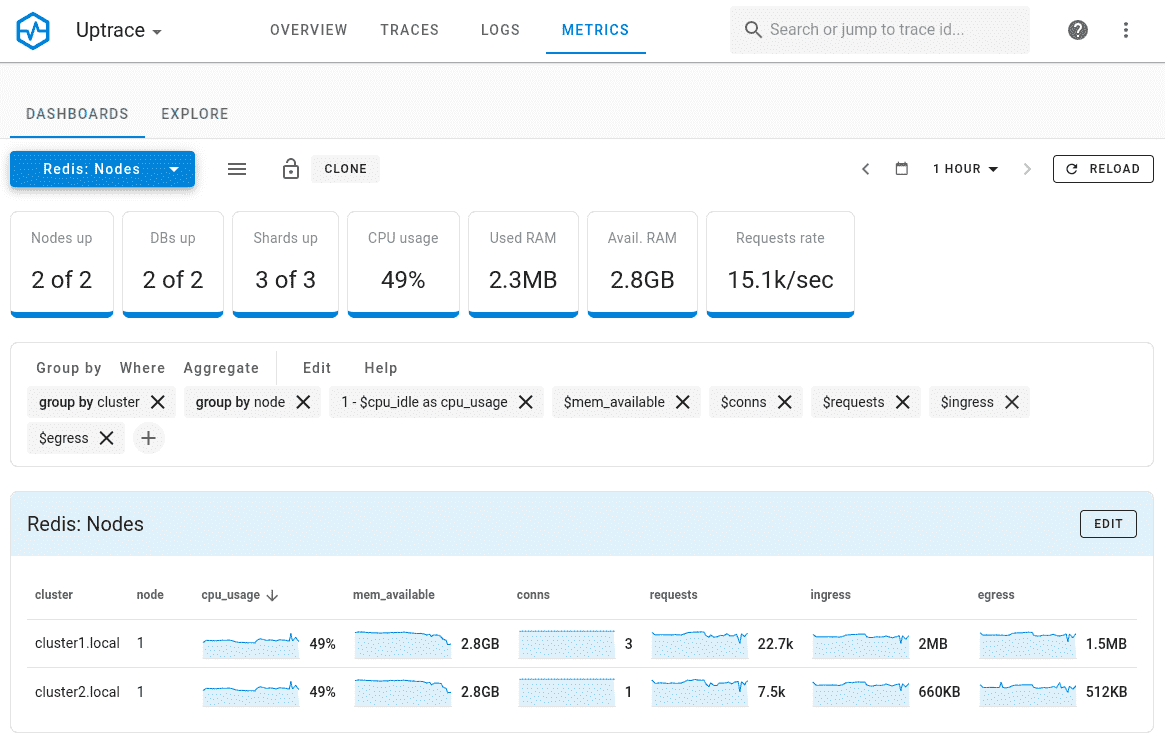
Using OpenTelemetry with PostgreSQL gives you a comprehensive view of your database's performance and its impact on the overall system. It helps you identify performance bottlenecks, troubleshoot issues, and optimize the database for better efficiency.
Features:
- OpenTelemetry-native architecture with intuitive query builder
- Rich dashboards and automatic alerts
- Unified visibility across databases, APIs, and application code
- Integration with OpenTelemetry Collector for PostgreSQL metrics
Best for: Teams using OpenTelemetry for distributed systems monitoring
Pricing: Free open source; commercial licenses available
SigNoz
SigNoz is an open-source OpenTelemetry-native APM that provides PostgreSQL monitoring through distributed tracing and metrics collection.
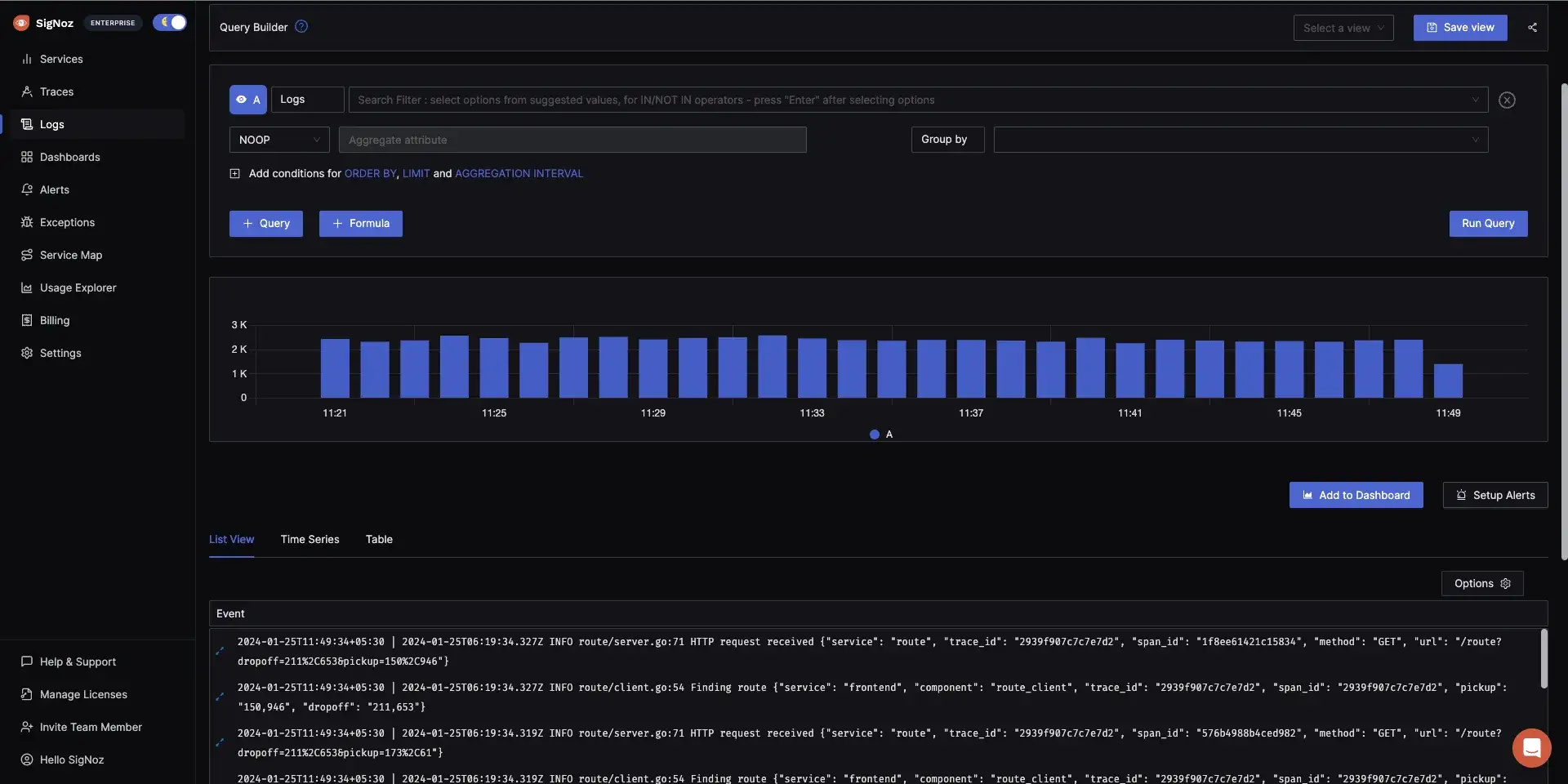
SigNoz monitors PostgreSQL databases through OpenTelemetry by collecting metrics using the OpenTelemetry Collector and visualizing data with built-in dashboards. It correlates database metrics with application traces to provide end-to-end visibility.
The platform tracks query performance, connection metrics, and database resource utilization while linking slow queries to specific application requests. This helps identify how database performance impacts overall application behavior.
Features:
- OpenTelemetry-native architecture
- Distributed tracing with database query correlation
- Pre-built PostgreSQL dashboards
- Query performance analysis
Best for: Teams adopting OpenTelemetry standards for cloud-native PostgreSQL monitoring
Pricing: Free open source; cloud version available
PostgreSQL-Specific Tools
pganalyze
pganalyze specializes in PostgreSQL performance monitoring and query optimization, providing detailed insights into query execution and index usage.

pganalyze automatically collects query statistics from pg_stat_statements and system catalogs to identify slow queries, missing indexes, and inefficient query patterns. The platform provides explain plan visualization and index recommendations to optimize database performance.
Features:
- Automatic query performance tracking
- Index recommendations based on workload analysis
- Explain plan visualization
- Historical query performance trends
- Vacuum and bloat monitoring
Best for: Database administrators focused on PostgreSQL query optimization and performance tuning
Pricing: Production tier starts at $149/month per database server
Open-Source Administration Tools
pgAdmin
pgAdmin is a tool for designing and managing PostgreSQL databases. It has a graphical interface for administering databases and features for monitoring server activity, query performance, and database objects.
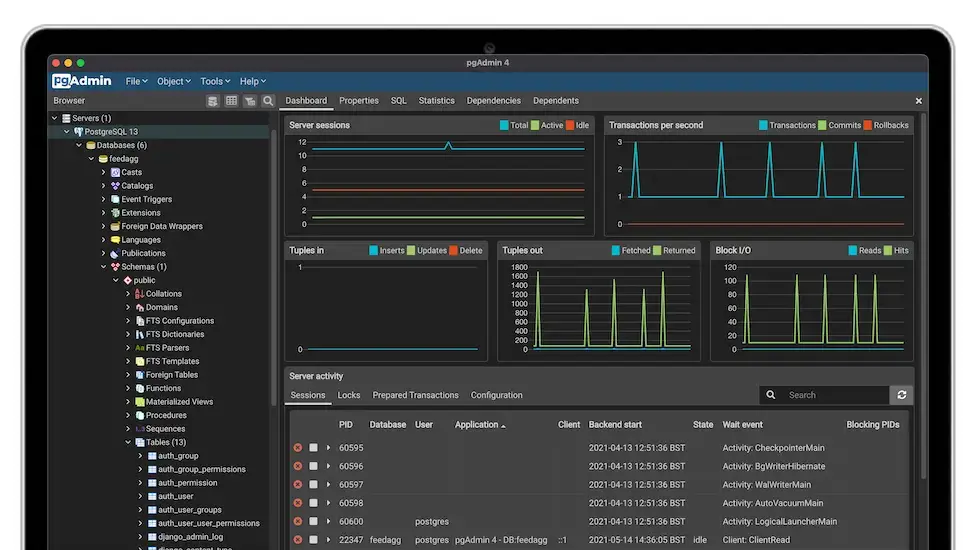
The server dashboard in pgAdmin offers an overview of important metrics, including CPU usage, memory usage, disk space, and active connections. This dashboard provides a quick snapshot of your PostgreSQL server's health and performance.
pgAdmin has a log file viewer that enables you to view and search PostgreSQL log files directly from the graphical interface. This feature can be used to monitor database activity, identify errors, and troubleshoot issues.
Although not as comprehensive as specialized monitoring solutions, pgAdmin offers basic alerting and notification capabilities. You can set up alerts for particular events, such as database connection failures or high CPU usage, and receive email notifications.
Features:
- Graphical interface for database administration
- Server dashboard with CPU, memory, disk space metrics
- Log file viewer for searching PostgreSQL logs
- Basic alerting for connection failures and resource usage
Best for: Development environments and basic PostgreSQL administration
Pricing: Free open source
pgBadger
pgBadger is a powerful log analyzer that generates detailed reports from PostgreSQL log files. It can help you identify slow queries, top SQL statements and general database performance issues.
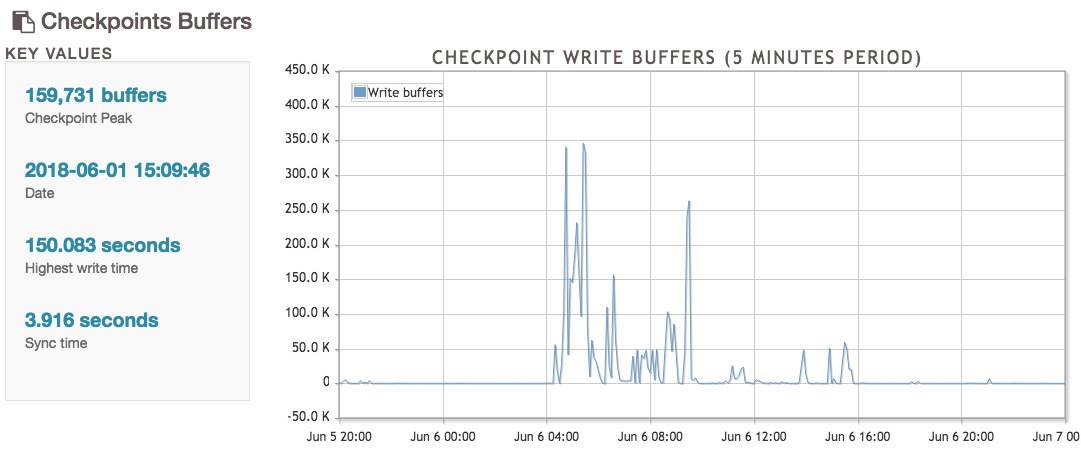
pgBadger is a powerful open source log analyzer for PostgreSQL. It is designed to analyze PostgreSQL log files and generate detailed reports and statistics to help you understand the performance and behavior of your PostgreSQL database.
With pgBadger you can gain insight into slow queries, top SQL statements, resource usage and other valuable information to optimize and troubleshoot your PostgreSQL database.
pgBadget is a useful tool for PostgreSQL administrators, developers and performance analysts who want to gain deeper insight into the behavior of their PostgreSQL database and identify areas for improvement.
Features:
- Detailed log file analysis and reporting
- Slow query identification with execution statistics
- Top SQL statements ranking
- Resource usage analysis and visualization
- HTML report generation
Best for: Log analysis and identifying slow queries from PostgreSQL log files
Pricing: Free open source
Percona Monitoring and Management
PMM is a free and open source monitoring solution designed specifically for open source databases, including PostgreSQL. It provides a set of dashboards and in-depth performance analysis capabilities.
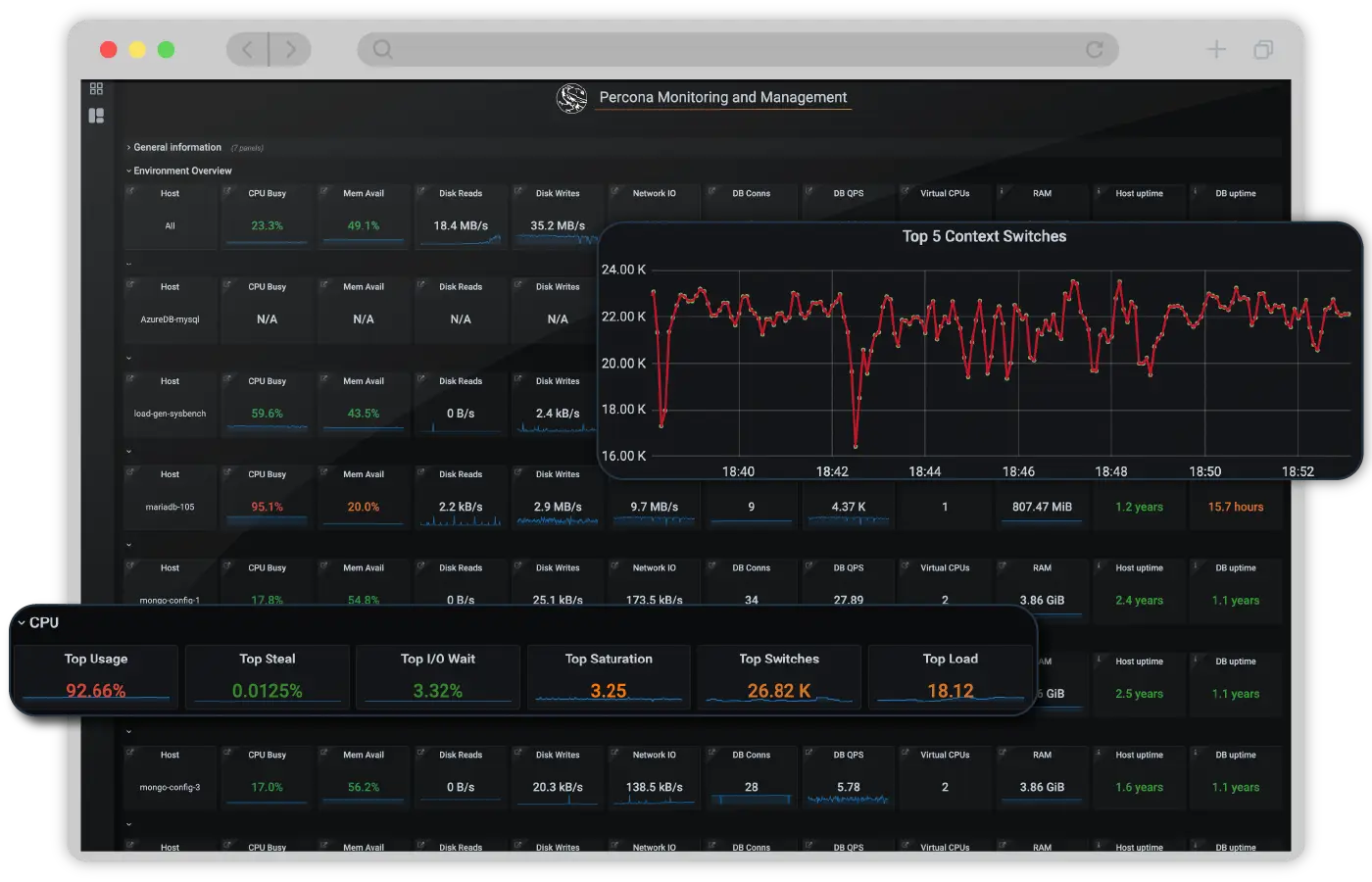
Percona Monitoring and Management (PMM) is a free and open source platform designed to monitor and manage the performance of database environments, including various open source databases such as MySQL, PostgreSQL, and MongoDB.
PMM provides real-time monitoring of your database environment, collecting metrics and data at frequent intervals to give you up-to-the-minute insight into the performance and health of your database instances.
PMM provides easy-to-use and customizable dashboards that display performance metrics, system resource utilization, and other relevant information. These visualizations help you quickly identify trends and potential problems.
Features:
- Real-time monitoring with frequent metric collection
- Customizable dashboards for performance visualization
- Multi-database support (MySQL, PostgreSQL, MongoDB)
- In-depth performance analysis capabilities
- System resource utilization tracking
Best for: Organizations running multiple open source databases (MySQL, PostgreSQL, MongoDB)
Pricing: Free open source
Time-Series Monitoring Solutions
Prometheus + Grafana
Prometheus is a popular open source monitoring and alerting tool that can be used to monitor PostgreSQL databases.

Prometheus can be easily integrated with PostgreSQL using the PostgreSQL Exporter. The exporter exposes data and metrics from the PostgreSQL database, allowing Prometheus to collect and store time series data for monitoring.
The PostgreSQL Exporter can collect a wide range of metrics from PostgreSQL, including database size, replication lag, available storage, latency, cache usage, and more. This provides a comprehensive view of the performance and health of your PostgreSQL database.
Prometheus can be used in conjunction with Grafana, a popular open source visualization tool, to create custom dashboards and visualize the collected metrics. Grafana provides an easy-to-use interface for creating interactive and customizable dashboards, allowing you to monitor PostgreSQL metrics in a visually appealing and intuitive way.
Features:
- PostgreSQL Exporter for metrics collection
- Time-series data storage and querying
- Comprehensive metric coverage (size, lag, latency, cache)
- Grafana integration for custom dashboards
- Interactive and customizable visualizations
Best for: Kubernetes environments and organizations using Prometheus for infrastructure monitoring
Pricing: Free open source
Commercial Observability Platforms
Datadog
DataDog is a commercial monitoring and analysis platform that provides specialized PostgreSQL integration, allowing you to monitor and analyze PostgreSQL performance metrics. It provides an easy-to-use dashboard and alerting capabilities.
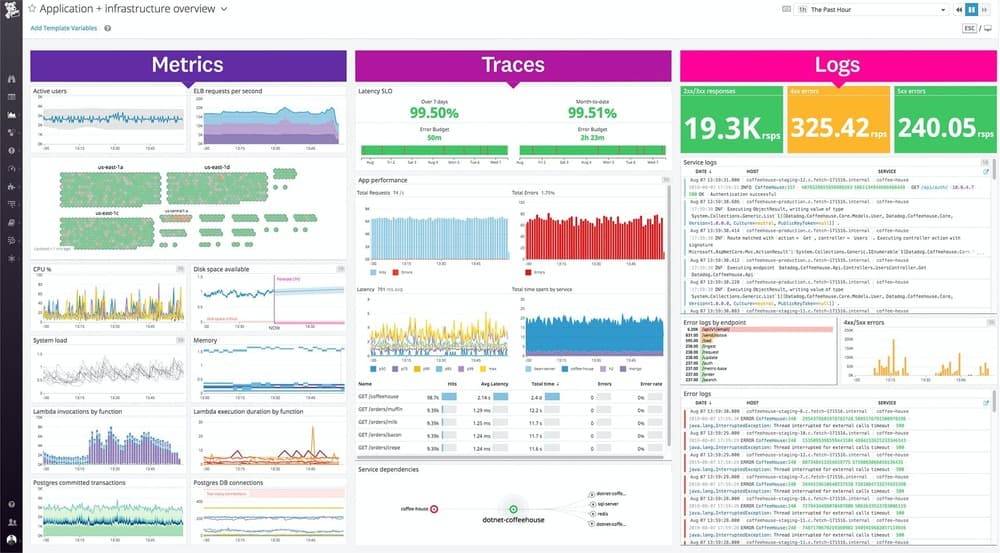
DataDog provides a PostgreSQL integration that allows you to collect and monitor PostgreSQL metrics without any manual instrumentation. The DataDog Agent automatically scrapes PostgreSQL metrics exposed by the server.
The DataDog Agent collects various PostgreSQL-specific metrics such as database connections, query performance, buffer pool statistics, replication status, and more. These metrics give you insight into the health and performance of your PostgreSQL database.
DataDog provides an easy-to-use dashboard interface that allows you to create custom dashboards with graphs and visualizations based on collected PostgreSQL metrics. This helps you monitor database behavior and performance at a glance.
Features:
- Automatic PostgreSQL metrics collection via DataDog Agent
- Database connections and query performance tracking
- Buffer pool statistics and replication status monitoring
- Custom dashboards with graphs and visualizations
- Easy-to-use interface for monitoring at a glance
Best for: Enterprise environments requiring unified monitoring across infrastructure, applications, and databases
Pricing: Database monitoring from $70/host/month; infrastructure monitoring from $15/host/month (minimum $85/month)
New Relic
New Relic offers full-stack observability including PostgreSQL monitoring integrated with application performance monitoring (APM).
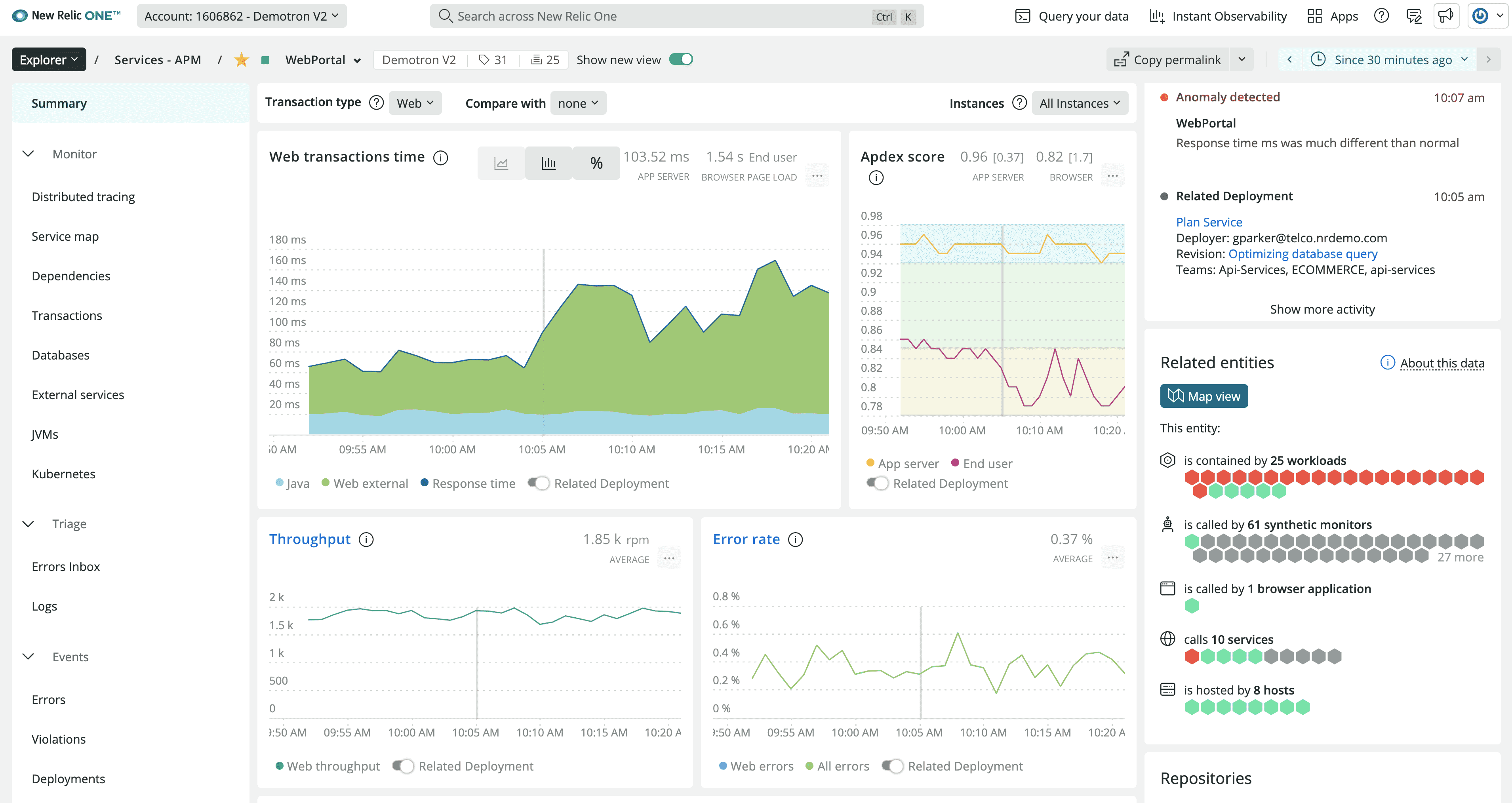
New Relic automatically correlates database query performance with application traces, helping identify how PostgreSQL performance impacts user experience. The platform provides query-level insights, execution plans, and resource utilization metrics within application context.
Features:
- Query-level performance tracking integrated with APM
- Automatic correlation between database and application performance
- Real-time alerting on database anomalies
- Historical performance trending
Best for: Organizations needing PostgreSQL monitoring integrated with full-stack application observability
Pricing: Usage-based pricing; free tier available with 100GB data/month
Zabbix
Zabbix is an open-source monitoring solution that supports PostgreSQL monitoring through its various built-in templates or custom scripts. It can monitor database performance metrics and generate alerts based on predefined thresholds.
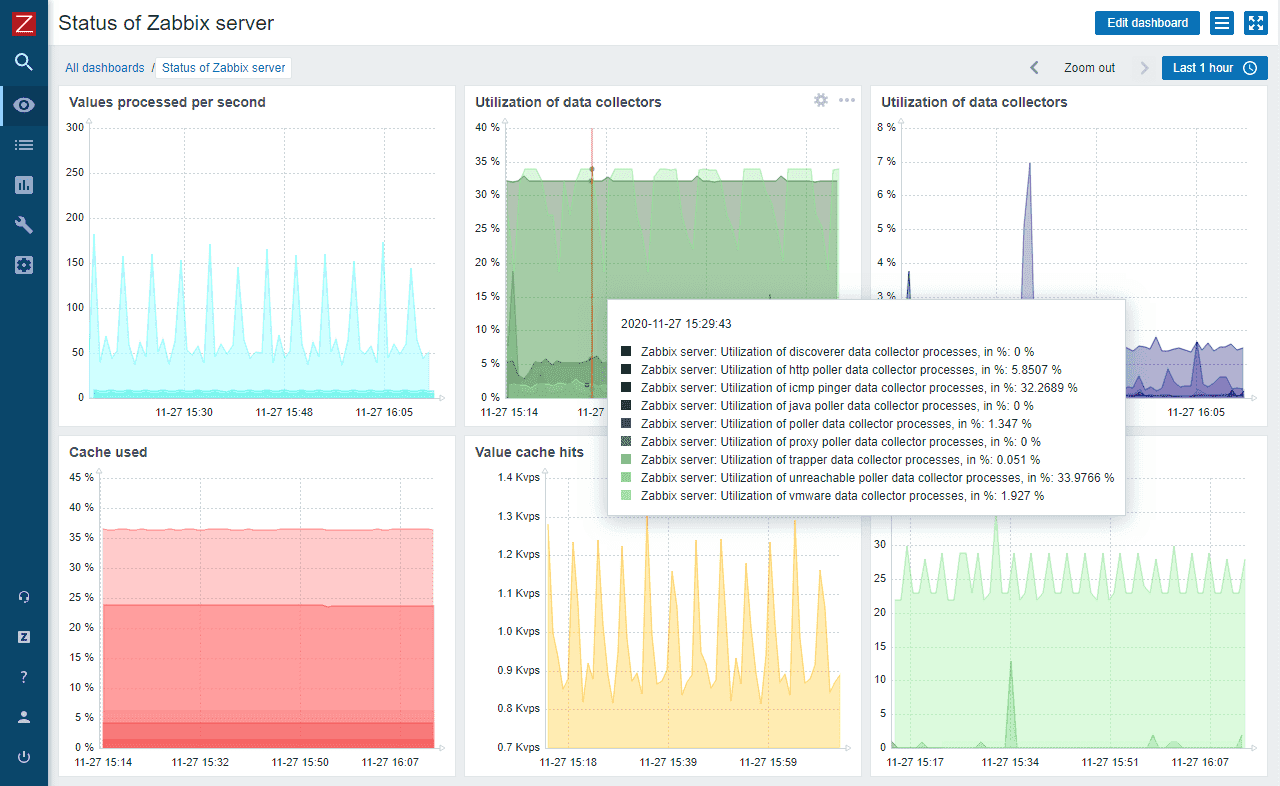
Zabbix relies on agents installed on the target systems to collect data. In the case of PostgreSQL, you need to enable monitoring by setting up the Zabbix agent on the PostgreSQL server.
After importing the PostgreSQL template, Zabbix will automatically collect PostgreSQL metrics such as connection counts, transaction rates, query performance and more. Additionally, you can define triggers to detect anomalies and trigger alerts when certain conditions are met.
Zabbix allows you to create custom charts to visualize PostgreSQL metrics over time. You can group related metrics and display them on a single dashboard for better monitoring.
Features:
- Built-in PostgreSQL templates for quick setup
- Automatic metrics collection (connections, transactions, queries)
- Customizable triggers for anomaly detection
- Custom charts and dashboard creation
- Comprehensive alerting system
Best for: Large-scale deployments requiring comprehensive infrastructure and database monitoring with customizable alerting
Pricing: Free open source
Conclusion
When choosing a PostgreSQL monitoring tool, consider factors such as the level of detail you need, ease of integration with your existing monitoring infrastructure, scalability, and the features that best suit your specific monitoring needs.
In addition, make sure that the tool is compatible with your version of PostgreSQL, as some features may be version-specific.
FAQ
What are PostgreSQL monitoring tools? PostgreSQL monitoring tools track database performance metrics including query execution time, connection counts, cache hit ratios, replication lag, and resource utilization. They help identify slow queries, prevent bottlenecks, and optimize database performance through real-time monitoring and alerting.
What is the best PostgreSQL monitoring tool? The best PostgreSQL monitoring tool depends on requirements. pganalyze ($149/month) specializes in query optimization. Datadog ($85/month) offers enterprise observability. Uptrace and SigNoz provide free OpenTelemetry-based monitoring. Prometheus + Grafana works well for Kubernetes environments.
What are the key metrics to monitor in PostgreSQL? Key PostgreSQL metrics include query execution time, cache hit ratio (target >99%), active connections, transaction rate, replication lag, table bloat, vacuum activity, and resource usage (CPU, memory, disk I/O). Monitor pg_stat_statements for query-level insights and pg_stat_database for database-wide statistics.
How do you monitor PostgreSQL performance? Monitor PostgreSQL performance using pg_stat_statements for query metrics, pg_stat_activity for active connections, and monitoring tools like Uptrace, pganalyze, or Datadog. Track cache hit ratios, slow queries, connection pools, and replication lag. Set alerts for performance degradation and analyze trends over time.
Which tools offer query-level monitoring? pganalyze specializes in query-level analysis with explain plans and index recommendations ($149/month). SigNoz correlates queries with application traces. Datadog provides query samples and execution plans. New Relic integrates query performance with APM. pg_stat_statements extension offers free query-level statistics.
Are there free PostgreSQL monitoring tools? Yes, free PostgreSQL monitoring tools include Uptrace (open source), Prometheus + Grafana, pgAdmin, pgBadger, Percona PMM, and Zabbix. These tools require setup but provide comprehensive monitoring without licensing costs. pg_stat_statements extension is built into PostgreSQL for query monitoring. Compare monitoring platforms with Datadog vs Grafana and Datadog vs Prometheus, or explore top APM tools for broader application monitoring needs.